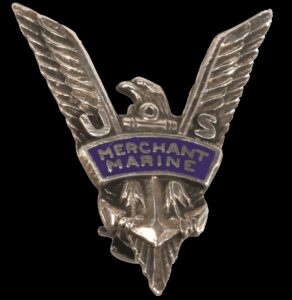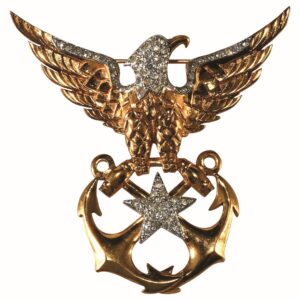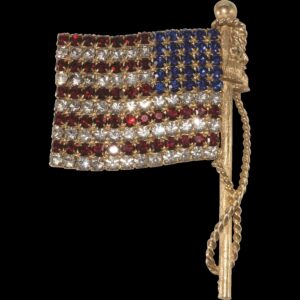Celebrating with Patriotic Jewelry
Add sparkle with star-spangled style

Joseff of Hollywood eagle pin,
early 2000s, $135-175
By Pamela Wiggins Siegel
Photographs courtesy of Jay B. Siegel
For many jewelry collectors, Independence Day is one occasion throughout the year when foraging a stash of adornment to don a patriotic piece or two is in order. This can range from jewelry shaped like eagles and flags to pieces crafted with red, white, and blue beads. And, of course, there are noteworthy anecdotes attached to many of those collectibles.
I was reminded of some of those stories when I visited the Tower of London recently and saw a plethora of red ceramic poppies on display to mark the 80th anniversary of the end of World War II. Many “V for Victory” pins were worn the world over back then, including many sported by proud Americans. I also touched on some patriotic jewelry a couple of months ago when I mentioned McClelland Barclay pieces featured in a “Fashion Takes to Wings” ad campaign in 1941. Those amazing baubles with a nod to patriotism were indeed adorned with wing-shaped elements in honor of the service members of World War II.

“V for Victory”
sterling silver pin, 1940s, $30-35
Some amazing wearable expressions of national pride were produced during the 1940s, but there’s a lot to love about all the patriotic adornment crafted since then. Let’s start with sweetheart jewelry because no overview of patriotic jewelry would be complete without it. Then, look at some other more recent times when a show of national celebration or support called for adornment.
Sweetheart Jewelry
It’s been quite a few years since I wrote about sweetheart jewelry, so I’ll begin with a refresher. In essence, this type of jewelry is a subset of patriotic jewelry since most of it was made and worn during World War II to show support for United States servicemen. The sweetheart in the name refers to these items donned by women waiting for their boyfriends and husbands to return from military service. They could also be worn by mothers to show support for their enlisted children.
The motifs in sweetheart jewelry vary widely, but most of these pieces have some form of reference to a branch of the military in the design. It might be as simple as a wire pin twisted to read “Sweetheart” with a metal star for an embellishment or a more elaborate eagle perched atop a pair of anchors. Pins were quite popular, but bracelets and necklaces were made by major manufacturers like Boucher, Coro, Trifari, and Accessocraft, among others. Some pieces, however, were handcrafted by soldiers and sent home to their loved ones. Many jewelry collectors fancy all of these items, but fans of militaria also add them to collections of sweetheart items that range from pillow covers and hankies to powder compacts.

Eagle sweetheart brooch
made by Boucher, 1940s, $250-300
To learn more about this type of sentimental adornment, check out Sweetheart Jewelry and Collectibles by Nick Snider (Schiffer Books). Although this title has been around for a while now, it is still a good reference for examining the vast array of jewelry in this category.
Bicentennial Jewelry
The American Bicentennial in 1976 offered another period in American history when an uptick in patriotic jewelry production was in order. This time, however, it was more about representing Colonial America and the red, white, and blue. Instead of being worn as a sentimental expression like sweetheart jewelry, Bicentennial jewelry was sported to celebrate 200 years of American freedom.
A new wave of manufacturers put their spin on patriotic jewelry rife with representations of eagles, the Founding Fathers, the Declaration of Independence, and the Liberty Bell. Avon sold pendants, Napier produced charm bracelets, and even Miriam Haskell marketed beaded jewelry with patriotic color schemes. Many of these items were made to remind Americans of the Spirit of ’76, so they’re found fairly frequently at estate sales and thrift shops, which may change as time passes. Still, as of now, bicentennial designs are not as expensive as some other patriotic pieces. That’s good news for buyers on a budget who would like to add a piece with a story to a growing collection.
Patriotic Jewelry in the Modern Era
As historically significant events go, there are none in modern American history more poignant than the events of September 11, 2001. When horrific acts of terrorism occurred that day and stunned the country, citizens were immediately driven to wear flag pins in a show of solidarity. They also paid tribute to the victims and first responders who lost their lives that day with those patriotic gestures. It didn’t matter how old the flag was, which company made it, or whether it was enameled or sprinkled with rhinestones; the vintage marketplace was quickly scoured for these pins.

Thelma Deutsch flag pin,
c. 1985, $65-85
More than two decades later, vintage flag pins are still sure sellers for costume jewelry marketers. However, a particular jewelry business has long specialized in supplying icons of national pride to VIPs and ordinary Americans alike: Ann Hand. Since the late 1980s, Hand has been creating jewelry depicting flags, eagles, and American landmarks worn by everyone from First Ladies to senators. Former Secretary of State Madeleine Albright added several of Hand’s designs to her famed “Read My Pins” collection.
Heidi Daus has also sold other more recent patriotic styles through HSN, and those usually feature rhinestones in shapes like Uncle Sam hats and eagles in eye-catching sizes. On QVC, the Kirk’s Folly brand of fanciful jewelry also sold flag brooches in several styles and guardian angels holding small flags or the initials U.S. Another whimsical brand, Lunch at the Ritz, also sold designs with lots of enameled dangling elements reflecting the stars and stripes and fireworks associated with the Fourth of July.
Of course, many other jewelry brands have produced collectible pieces with a patriotic twist, from Thelma Deutsch in the 1980s and ‘90s to Joseff of Hollywood (still making them), incorporating their stockpile of old components from the 1930s and 1940s. That’s one of the best aspects of exploring a topic like this one since there are many different ways to express patriotism, whether you prefer something sentimental, traditional, elegant, or a piece with a touch of whimsy.
PAMELA WIGGINS SIEGEL has been buying, selling, and collecting costume jewelry for more than 30 years. She is the author of Warman’s Costume Jewelry (Krause Publications) and the co-founder of Costume Jewelry Collectors Int’l, an organization dedicated to hosting events and providing educational resources for collectors. Visit her online at www.chicantiques.com and www.cjci.co.
You May Also Like:
Military Collectors at Attention